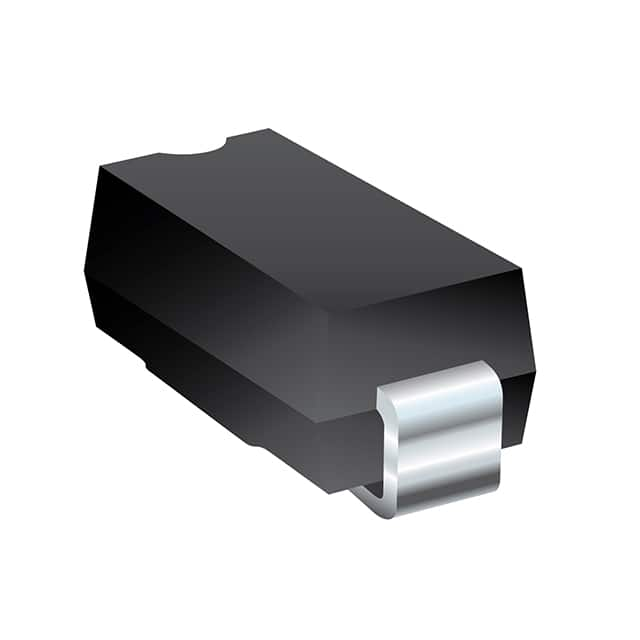SMAJ7.0A Diode: Product Overview and Specifications
Introduction
The SMAJ7.0A diode is a crucial component in electronic circuits, belonging to the category of transient voltage suppressor (TVS) diodes. This diode is widely used for protecting sensitive electronic devices from voltage spikes and transients. Its characteristics, packaging, specifications, pin configuration, functional features, advantages, disadvantages, working principles, application field plans, and alternative models are detailed below.
Basic Information Overview
- Category: Transient Voltage Suppressor (TVS) Diode
- Use: Protection against voltage spikes and transients
- Characteristics: Fast response time, low clamping voltage, high surge capability
- Package: SMA (DO-214AC)
- Essence: Provides robust protection for electronic circuits
- Packaging/Quantity: Available in tape and reel packaging, quantity varies by manufacturer
Specifications
- Part Number: SMAJ7.0A
- Peak Pulse Power: 400W
- Breakdown Voltage: 7.0V
- Operating Voltage: 6.4V
- Clamping Voltage: 11.2V
- Maximum Surge Current: 30A
- Operating Temperature Range: -55°C to +150°C
Detailed Pin Configuration
The SMAJ7.0A diode has two pins: 1. Anode (A) 2. Cathode (K)
Functional Features
- Transient Suppression: Rapidly clamps transient voltages to safe levels
- Low Clamping Voltage: Protects sensitive components by limiting voltage excursion
- Fast Response Time: Reacts quickly to transient events, minimizing potential damage
- High Surge Capability: Withstands large surge currents without degradation
Advantages and Disadvantages
Advantages
- Effective protection against voltage spikes
- Compact size for easy integration into circuits
- Wide operating temperature range
Disadvantages
- Limited surge current handling compared to higher-rated TVS diodes
- Higher clamping voltage compared to some specialized TVS diodes
Working Principles
When a transient voltage spike occurs, the SMAJ7.0A diode conducts and clamps the voltage to a safe level, diverting excess current away from sensitive components. This rapid response protects the circuit from damage caused by voltage surges.
Detailed Application Field Plans
The SMAJ7.0A diode finds extensive use in various applications, including: - Power supply units - Communication equipment - Automotive electronics - Industrial control systems - Consumer electronics
Detailed and Complete Alternative Models
Several alternative TVS diodes can be considered as substitutes for the SMAJ7.0A, including: - P6KE6.8A - 1.5KE6.8A - SMBJ7.0A - SMCJ7.0A
In conclusion, the SMAJ7.0A diode serves as a critical component in safeguarding electronic circuits from voltage transients and spikes. Its fast response time, low clamping voltage, and high surge capability make it an essential choice for various applications.
Word Count: 411
قم بإدراج 10 أسئلة وإجابات شائعة تتعلق بتطبيق SMAJ7.0A في الحلول التقنية
What is SMAJ7.0A?
- SMAJ7.0A is a surface mount transient voltage suppressor diode that is commonly used to protect electronic circuits from overvoltage events.
What is the maximum peak pulse power of SMAJ7.0A?
- The maximum peak pulse power of SMAJ7.0A is 400 watts.
What is the breakdown voltage of SMAJ7.0A?
- The breakdown voltage of SMAJ7.0A is 7.0 volts.
How does SMAJ7.0A protect electronic circuits?
- SMAJ7.0A suppresses transient voltage spikes by diverting excess current away from sensitive components, thus protecting them from damage.
What are the typical applications of SMAJ7.0A?
- SMAJ7.0A is commonly used in telecommunications equipment, consumer electronics, industrial automation, and automotive systems to protect against voltage transients.
What is the operating temperature range of SMAJ7.0A?
- The operating temperature range of SMAJ7.0A is typically -55°C to 150°C.
Is SMAJ7.0A RoHS compliant?
- Yes, SMAJ7.0A is RoHS compliant, meaning it meets the Restriction of Hazardous Substances directive.
What is the package type of SMAJ7.0A?
- SMAJ7.0A is available in a DO-214AC (SMA) package.
Can SMAJ7.0A be used for ESD protection?
- While SMAJ7.0A is primarily designed for transient voltage suppression, it can also provide some level of electrostatic discharge (ESD) protection.
Are there any recommended layout considerations when using SMAJ7.0A?
- It is recommended to minimize the length of the traces between SMAJ7.0A and the protected circuitry and to ensure a low impedance path to ground for optimal performance.


